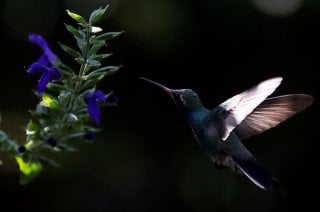Study Shows Hummingbirds Can See Colors That Humans Can’t
Humans possess three types of color-sensitive cones in their eyes that are attuned to red, green and blue light. Birds, however, make use of a fourth type of cone that is sensitive to ultraviolet light.
From performing intricate surgeries or hitting baseballs that come at us at 100 miles per hour, we humans might think that we have pretty decent vision.
But according to a recent study published in the journal Proceedings of National Academy of Sciences, our color vision doesn’t come close to rivaling those of many birds, who often use this sense to escape predators and find food.
“Humans are color-blind compared to birds and many other animals,” Mary Caswell Stoddard, an assistant professor in the Princeton University Department of Ecology and Evolutionary Biology, said in a release.
Humans possess three types of color-sensitive cones in their eyes, and they are attuned to red, green and blue light. Birds, however, make use of a fourth type that is sensitive to ultraviolet light.
“Not only does having a fourth color cone type extend the range of bird-visible colors into the UV, it potentially allows birds to perceive combination colors like ultraviolet+green and ultraviolet+red—but this has been hard to test,” Stoddard said.
In order to better understand how birds visually perceive their colorful world, Stoddard and her research team created a new field system to test bird color vision in a natural setting.
At the Rocky Mountain Biological Laboratory in Gothic, Colorado, the research team was able to train wild broad-tailed hummingbirds (Selasphorus platycercus) to take part in color-vision experiments.
“Most detailed perceptual experiments on birds are performed in the lab, but we risk missing the bigger picture of how birds really use color vision in their daily lives,” Stoddard said.
“Hummingbirds are perfect for studying color vision in the wild. These sugar fiends have evolved to respond to flower colors that advertise a nectar reward, so they can learn color associations rapidly and with little training.”
Over three field seasons from 2016 to 2018, the scientists conducted nineteen experiments and witnessed roughly six thousand hummingbird visits. The remarkable results revealed the birds could discern spectral-colored feeders from feeders in nonspectral colors.
Humans only have just one nonspectral color, which is purple but birds can see up to five: purple, ultraviolet+red, ultraviolet+green, ultraviolet+yellow and ultraviolet+purple.
However, truly understanding how these colors appear to the birds can be quite difficult.
“It is impossible to really know how the birds perceive these colors,” Ben Hogan, a postdoctoral research associate at Princeton and a co-author of the study, said in a release. “Is ultraviolet+red a mix of those colors, or an entirely new color? We can only speculate.”
Ethen Kim Lieser is a Minneapolis-based Science and Tech Editor who has held posts at Google, The Korea Herald, Lincoln Journal Star, AsianWeek and Arirang TV. Follow or contact him on LinkedIn.
Image: Reuters

